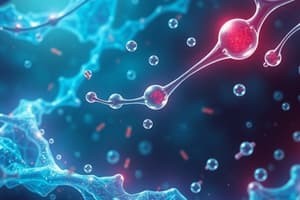Podcast
Questions and Answers
What is the primary mechanism of action of cholinergic antagonists?
What is the primary mechanism of action of cholinergic antagonists?
- Enhancing acetylcholine activity
- Stimulating nicotinic receptors
- Inhibiting parasympathetic ganglia
- Blocking muscarinic receptors (correct)
What type of receptors do ganglionic blockers target?
What type of receptors do ganglionic blockers target?
- Neuromuscular receptors
- Nicotinic receptors of sympathetic and parasympathetic ganglia (correct)
- Muscarinic receptors
- Adrenergic receptors
What is the primary therapeutic use of neuromuscular-blocking agents?
What is the primary therapeutic use of neuromuscular-blocking agents?
- Increasing salivary secretion
- Relaxing skeletal muscles during anesthesia (correct)
- Treating glaucoma
- Treating hypertension
What is the mechanism of action of atropine?
What is the mechanism of action of atropine?
What is the duration of atropine's general actions?
What is the duration of atropine's general actions?
What is the effect of atropine on sweat glands?
What is the effect of atropine on sweat glands?
What is the primary effect of atropine on the eye?
What is the primary effect of atropine on the eye?
Which of the following drugs also has antimuscarinic activity?
Which of the following drugs also has antimuscarinic activity?
What is the classification of atropine?
What is the classification of atropine?
Why are neuromuscular-blocking agents not effective when taken orally?
Why are neuromuscular-blocking agents not effective when taken orally?
What happens to pancuronium in the body?
What happens to pancuronium in the body?
Why is cisatracurium preferred over atracurium?
Why is cisatracurium preferred over atracurium?
How do cholinesterase inhibitors affect nondepolarizing neuromuscular blockers?
How do cholinesterase inhibitors affect nondepolarizing neuromuscular blockers?
What is the effect of halogenated hydrocarbon anesthetics on neuromuscular blockade?
What is the effect of halogenated hydrocarbon anesthetics on neuromuscular blockade?
What is the purpose of choosing a specific neuromuscular-blocking agent?
What is the purpose of choosing a specific neuromuscular-blocking agent?
What is a common adverse effect of atracurium?
What is a common adverse effect of atracurium?
What happens to vecuronium and rocuronium in the liver?
What happens to vecuronium and rocuronium in the liver?
Why are the amino steroid drugs excreted unchanged in bile?
Why are the amino steroid drugs excreted unchanged in bile?
What is the primary reason for using atropine as an antisecretory agent?
What is the primary reason for using atropine as an antisecretory agent?
What is the typical duration of atropine treatment for organophosphate poisoning?
What is the typical duration of atropine treatment for organophosphate poisoning?
What is the primary route of atropine elimination?
What is the primary route of atropine elimination?
What is a common adverse effect of atropine on the central nervous system?
What is a common adverse effect of atropine on the central nervous system?
What is the half-life of atropine?
What is the half-life of atropine?
What is the primary difference between atropine and scopolamine?
What is the primary difference between atropine and scopolamine?
What can be used to overcome atropine toxicity?
What can be used to overcome atropine toxicity?
Why is atropine particularly dangerous in children?
Why is atropine particularly dangerous in children?
What is the primary mechanism of action of atropine in treating cholinergic agonist poisoning?
What is the primary mechanism of action of atropine in treating cholinergic agonist poisoning?
What is the primary mechanism of action of nondepolarizing agents at low doses?
What is the primary mechanism of action of nondepolarizing agents at low doses?
Which of the following muscles is most susceptible to blockade by competitive agents?
Which of the following muscles is most susceptible to blockade by competitive agents?
What is the effect of administering cholinesterase inhibitors, such as neostigmine and edrophonium, to patients receiving nondepolarizing agents?
What is the effect of administering cholinesterase inhibitors, such as neostigmine and edrophonium, to patients receiving nondepolarizing agents?
At high doses, what is the primary mechanism of action of nondepolarizing agents?
At high doses, what is the primary mechanism of action of nondepolarizing agents?
What is the role of sugammadex in anesthesia?
What is the role of sugammadex in anesthesia?
What is the sequence of muscle paralysis when using nondepolarizing agents?
What is the sequence of muscle paralysis when using nondepolarizing agents?
What is the effect of nondepolarizing agents on neuromuscular transmission at high doses?
What is the effect of nondepolarizing agents on neuromuscular transmission at high doses?
What is the role of direct electrical stimulation from a peripheral nerve stimulator in monitoring neuromuscular blockade?
What is the role of direct electrical stimulation from a peripheral nerve stimulator in monitoring neuromuscular blockade?
What is the advantage of cisatracurium, pancuronium, rocuronium, and vecuronium over tubocurarine?
What is the advantage of cisatracurium, pancuronium, rocuronium, and vecuronium over tubocurarine?
What is the primary reason for administering a small dose of nondepolarizing neuromuscular blocker prior to succinylcholine?
What is the primary reason for administering a small dose of nondepolarizing neuromuscular blocker prior to succinylcholine?
What is the primary mechanism of action of succinylcholine?
What is the primary mechanism of action of succinylcholine?
What is a common therapeutic use of succinylcholine?
What is a common therapeutic use of succinylcholine?
What is a potential adverse effect of succinylcholine in patients with electrolyte imbalances?
What is a potential adverse effect of succinylcholine in patients with electrolyte imbalances?
Why should succinylcholine be used cautiously in patients receiving digoxin or diuretics?
Why should succinylcholine be used cautiously in patients receiving digoxin or diuretics?
What is the primary reason for the brief duration of action of succinylcholine?
What is the primary reason for the brief duration of action of succinylcholine?
What is a potential consequence of administering succinylcholine to a patient with an atypical form of plasma cholinesterase?
What is a potential consequence of administering succinylcholine to a patient with an atypical form of plasma cholinesterase?
What is the route of administration of succinylcholine?
What is the route of administration of succinylcholine?
What is a potential use of continuous infusion of succinylcholine?
What is a potential use of continuous infusion of succinylcholine?
Flashcards are hidden until you start studying
Study Notes
Cholinergic Antagonists
- Cholinergic antagonists are agents that bind to cholinoceptors and prevent the effects of acetylcholine (ACh) and other cholinergic agonists.
Antimuscarinic Agents
- Antimuscarinic agents, also known as anticholinergic drugs, block muscarinic receptors, causing inhibition of muscarinic functions.
- Examples of antimuscarinic agents include atropine and scopolamine.
- These drugs block some sympathetic neurons that are cholinergic, such as the salivary and sweat glands.
- They do not block nicotinic receptors, and therefore have little or no action at skeletal neuromuscular junctions (NMJs) or autonomic ganglia.
Atropine
- Atropine is a tertiary amine belladonna alkaloid with a high affinity for muscarinic receptors.
- It binds competitively and prevents ACh from binding to those sites.
- Atropine acts both centrally and peripherally, with general actions lasting about 4 hours, except when placed topically in the eye, where the action may last for days.
- Neuroeffector organs have varying sensitivity to atropine, with the greatest inhibitory effects on bronchial tissue and the secretion of sweat and saliva.
Actions of Atropine
- Eye: Atropine blocks muscarinic activity in the eye, resulting in mydriasis (dilation of the pupil), unresponsiveness to light, and cycloplegia (inability to focus for near vision).
- Cardiovascular: Atropine is used to treat bradycardia of varying etiologies.
- Antisecretory: Atropine is sometimes used as an antisecretory agent to block secretions in the upper and lower respiratory tracts prior to surgery.
- Antidote for cholinergic agonists: Atropine is used for the treatment of organophosphate (insecticides, nerve gases) poisoning, overdose of anticholinesterases such as physostigmine, and some types of mushroom poisoning.
Pharmacokinetics of Atropine
- Atropine is readily absorbed, partially metabolized by the liver, and eliminated primarily in urine.
- It has a half-life of about 4 hours.
Adverse Effects of Atropine
- Depending on the dose, atropine may cause dry mouth, blurred vision, “sandy eyes,” tachycardia, urinary retention, and constipation.
- Effects on the CNS include restlessness, confusion, hallucinations, and delirium, collapse of the circulatory and respiratory systems, and death.
Scopolamine
- Scopolamine, another tertiary amine plant alkaloid, produces peripheral effects similar to those of atropine.
- However, scopolamine has greater action on the CNS (unlike atropine, CNS effects are observed at therapeutic doses) and a longer duration of action as compared to atropine.
Neuromuscular-Blocking Agents (Nicotinic Antagonists)
- These agents interfere with the efferent impulses to skeletal muscles.
- They are used as skeletal muscle relaxant adjuvants in anesthesia during surgery, intubation, and various orthopedic procedures.
Mechanism of Action
- At low doses, nondepolarizing agents competitively block the nicotinic receptors without stimulating it.
- They prevent depolarization of the muscle cell membrane and inhibit muscular contraction.
- Their competitive action can be overcome by administration of cholinesterase inhibitors, such as neostigmine and edrophonium, which increase the concentration of ACh in the neuromuscular junction.
Actions
- Muscles have differing sensitivity to blockade by competitive agents.
- Small, rapidly contracting muscles of the face and eye are most susceptible and are paralyzed first, followed by the fingers, limbs, neck, and trunk muscles.
- Next, the intercostal muscles are affected, and lastly, the diaphragm.
- The muscles recover in the reverse manner.
Sugammadex
- Sugammadex is a selective relaxant-binding agent that terminates the action of both rocuronium and vecuronium and can be used to speed recovery.
Pharmacokinetics of Neuromuscular-Blocking Agents
- All neuromuscular-blocking agents are injected intravenously or occasionally intramuscularly since they are not effective orally.
- These agents possess two or more quaternary amines in their bulky ring structure that prevent their absorption from the gut.
- They penetrate membranes very poorly and do not enter cells or cross the blood–brain barrier.
- Many of the drugs are not metabolized, and their actions are terminated by redistribution.
- For example, pancuronium is excreted unchanged in urine.
Adverse Effects
- In general, these agents are safe with minimal side effects.
- However, succinylcholine can potentially induce malignant hyperthermia in susceptible patients.
- Administration of succinylcholine to a patient who is deficient in plasma cholinesterase or who has an atypical form of the enzyme can lead to prolonged apnea due to paralysis of the diaphragm.
- The rapid release of potassium may also contribute to prolonged apnea in patients with electrolyte imbalances who receive this drug.
Studying That Suits You
Use AI to generate personalized quizzes and flashcards to suit your learning preferences.




